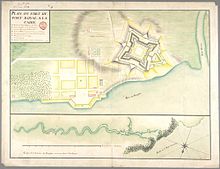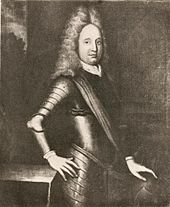Siege of Port Royal (1710)
Great Britain France The siege of Port Royal (5–13 October 1710),[n 1] also known as the Conquest of Acadia,[4] was a military siege conducted by British regular and provincial forces under the command of Francis Nicholson against a French Acadian garrison and the Wabanaki Confederacy[5] under the command of Daniel d'Auger de Subercase, at the Acadian capital, Port Royal.
[n 2] After the French surrender, the British occupied the fort in the capital with all the pomp and ceremony of having captured one of the great fortresses of Europe,[6] and renamed it Annapolis Royal.
[13] When Daniel d'Auger de Subercase became governor of Acadia in 1706, he went on the offensive, encouraging aboriginal raids against English targets in New England.
[15] However, the business was being hurt by the war, and some merchants began making vocal calls for action, and public outrage rose over the failure of the Massachusetts defenses to stop the French and aboriginal raids.
[16][17] Massachusetts Bay Governor Joseph Dudley had made repeated requests to London for support without any success, and finally decided to act independently to fend off accusations of complicity in the illegal trade.
[19] In the following years, France failed to send any significant support, while the British mobilized larger and better-organized forces for the conflict in North America.
Samuel Vetch, a Scots businessman with colonial ties, went to London in 1708 and lobbied Queen Anne for military support to conquer all of New France.
[21][22] Vetch and Francis Nicholson, an Englishman who had previously served as colonial governor of Maryland and Virginia, returned to England in its aftermath, and again appealed to the queen for support.
[24] Nicholson arrived in Boston on 15 July 1710, bearing a commission from the queen as "General and Commander-in-Chief of all and sundry the Forces, to be employed in the expedition design'd for the reducing of Port Royal in Nova Scotia".
[27] Subercase had taken steps to improve the local defences since the 1707 sieges, building a new bomb-proof powder magazine and barracks in 1708, and clearing woods from the river banks to deny attackers cover.
He completed the construction of another vessel to assist in naval defence, and engaged privateers with great success against New England fishing and shipping.
These terms called for the "Inhabitants within Cannon shot of the Fort" to be allowed to remain on their properties for up to two years if they so chose, provided they were willing to take an oath to the British Crown.
After a skirmish in which a party of British soldiers was ambushed, Bernard-Anselme d'Abbadie de Saint-Castin lead a force of 200 Acadians and native warriors in a siege of the fort, without success.
[38] The capture of Port Royal marked the end of French rule in peninsular Acadia, and inaugurated a struggle for control of the territory that lasted until the British conquests of the Seven Years' War.
[42] Acadia's border was not formally demarcated by the Treaty of Utrecht, which became a cause of ongoing friction between the British and French, especially on the Isthmus of Chignecto, which both sides eventually fortified.
The French interpreted the phrase ancient boundaries to imply only the peninsula of present-day Nova Scotia, thereby excluding the mainland between New England and the St. Lawrence, ÎLe St. Jean, and Cape Breton.
[44] However, after a three months crossing, and the dispersal of the fleet between Sable Island and the mainland, the expedition turned out to be a disaster for the French, and they would not try to recapture Port Royal again.





